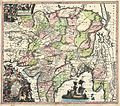File:1740 Seutter Map of India, Pakistan, Tibet and Afghanistan - Geographicus - IndiaMogolis-seutter-1740.jpg
Vai alla navigazione
Vai alla ricerca

Dimensioni di questa anteprima: 679 × 600 pixel. Altre risoluzioni: 272 × 240 pixel | 543 × 480 pixel | 869 × 768 pixel | 1 159 × 1 024 pixel | 2 318 × 2 048 pixel | 5 000 × 4 418 pixel.
File originale (5 000 × 4 418 pixel, dimensione del file: 8,42 MB, tipo MIME: image/jpeg)
Cronologia del file
Fare clic su un gruppo data/ora per vedere il file come si presentava nel momento indicato.
| Data/Ora | Miniatura | Dimensioni | Utente | Commento | |
|---|---|---|---|---|---|
| attuale | 22:49, 22 mar 2011 |  | 5 000 × 4 418 (8,42 MB) | BotMultichillT | {{subst:User:Multichill/Geographicus |link=http://www.geographicus.com/P/AntiqueMap/IndiaMogolis-seutter-1740 |product_name=1740 Seutter Map of India, Pakistan, Tibet and Afghanistan |map_title=Imperii Magni Mogolis sive Indici Padschach, juxta recentiiss |
Pagine che usano questo file
La seguente pagina usa questo file:
Utilizzo globale del file
Anche i seguenti wiki usano questo file:
- Usato nelle seguenti pagine di ar.wikipedia.org:
- Usato nelle seguenti pagine di beta.wikiversity.org:
- Usato nelle seguenti pagine di bn.wikipedia.org:
- Usato nelle seguenti pagine di ca.wikipedia.org:
- Usato nelle seguenti pagine di cs.wikipedia.org:
- Usato nelle seguenti pagine di el.wikipedia.org:
- Usato nelle seguenti pagine di en.wikipedia.org:
- Usato nelle seguenti pagine di eo.wikipedia.org:
- Usato nelle seguenti pagine di es.wikipedia.org:
- Usato nelle seguenti pagine di incubator.wikimedia.org:
- Usato nelle seguenti pagine di pnb.wikipedia.org:
- Usato nelle seguenti pagine di ru.wikipedia.org:
- Usato nelle seguenti pagine di te.wikipedia.org:
- Usato nelle seguenti pagine di ur.wikipedia.org:
- Usato nelle seguenti pagine di www.wikidata.org:



